Illuminate Adelaide to brighten the midwinter dark
Light festivals can bring art and culture to life with hi-tech projections and illuminated sculptures – and they are very popular.
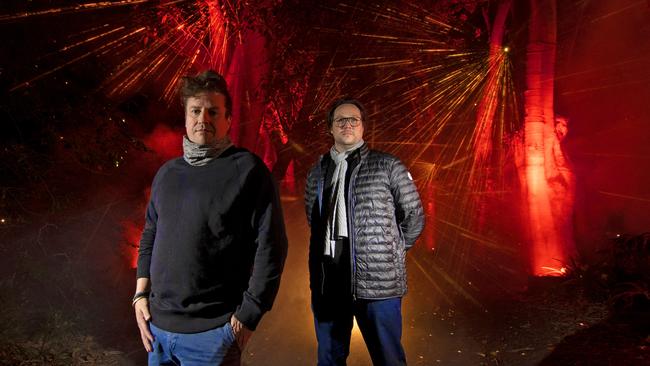
Mathieu Grainger and his team have been working odd hours in Adelaide for the past week or so – and not only because they’re Canadians on the far side of the world.
The producers from Montreal’s Moment Factory start their day at 3pm and finish at 3am, as they rummage around like nocturnal creatures in the city’s Botanic Gardens. Their work necessarily happens in darkness. They are installing a winter garden of illuminations – from tiny pixel-lights to hi-tech digital projections – that will enhance the night-time wonder of the garden’s arboreal splendours.
The installation called Light Cycles, across almost 2km of the Botanic Gardens, is a highlight of Illuminate Adelaide, a new midwinter festival that gets under way on Saturday. The official start has been postponed from Friday because of high winds forecast in Adelaide.
“We use lighting and multimedia digital projections, special effects and music to create tableaus – moments that you can immerse yourself in,” Grainger says. “They are like living art installations where you can walk through the forest.”
Across 17 days and nights, Adelaide will glow with illuminated street sculptures. Buildings will magically change colour and pattern. Artists from local digital effects studio Rising Sun Pictures have made an immersive light and animation show at Lot Fourteen, the city’s culture and technology precinct. There’s an accompanying program of exhibitions, talks and music, featuring artists in residence the Avalanches.
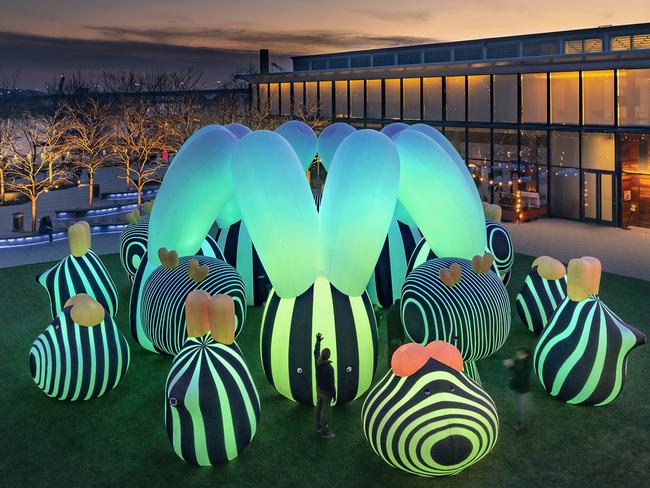
Adelaide’s $10m festival is just the latest event to flick the switch to electric dreams. Vivid Sydney has developed an enormous following for its midwinter illuminations across the city, most impressively on the sails of the Sydney Opera House. Pre-Covid, it attracted crowds of 2.3 million.
Other festivals – from Hobart’s Dark Mofo to Parrtjima in Alice Springs and Melbourne’s Rising – also lure people out of hibernation with displays of glowing light.
And Melbourne-based company Grande Experiences has built a global business out of exhibitions of paintings by Monet, van Gogh and others, all created through sophisticated projections. Its shows, including Van Gogh Alive, installed as part of Illuminate Adelaide, have been seen by 18 million people worldwide.
The enormous appeal of light shows is almost self-evident: we really are as moths to a flame. The latest technology involving digital projection produces eye-dazzling effects. Most of the events are outdoors, bringing people out of their homes – and, to the benefit of local businesses, spending money – to share the experience. And there are few barriers to enjoyment, whether language spoken, cultural background, or physical ability. It could all be described as smoke and mirrors, but producers are at pains to point out the creativity and spirit of collaboration that goes into making these hi-tech spectaculars.
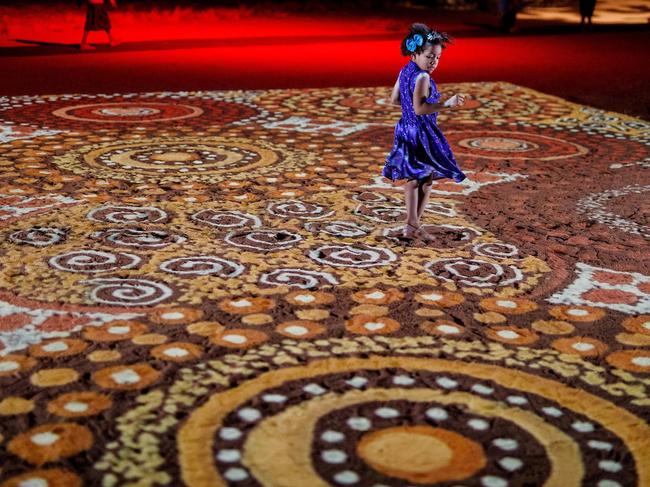
Illuminate Adelaide was co-founded by experienced arts producers Rachael Azzopardi and Lee Cumberlidge, who saw the opportunity for a festival around the convergence of creative industries, technology and science. The program is supported by the Marshall government, and the South Australian Tourism Commission came on board as principal sponsor for an initial three years. Although the event was conceived of before the pandemic, Cumberlidge says it is now seen as part of Adelaide’s post-Covid recovery.
“We wanted it to be really accessible, so that people can plan a night out in the city,” he says. “It’s designed to be largely outdoors, and throughout the city, so it stood up as an idea that could be easily adapted to the current reality around the gathering of people and live events.”
The emergence of light shows involving projections on to buildings is relatively recent, given they require high-powered illumination made possible only by electricity. Their origin is in son et lumiere attractions that developed in the mid-20th century, first in 1952 at Chambord, the chateau in the Loire Valley. A thunderstorm near the castle gave Paul Robert-Houdin the idea of re-creating the natural phenomena with artificial sound and lighting – hence son et lumiere.
The idea caught on, and son et lumiere attractions were installed in places as various as the pyramids in Egypt, the Acropolis in Athens and, more recently, at the Burj Khalifa in Dubai. A feature of the shows is that they are not performances involving actors but often are automated spectacles involving light, projections, a soundtrack and other effects.
Australian cities and natural wonders lend themselves to these night-time entertainments. The fireworks over Sydney Harbour on New Year’s Eve are a globally recognised symbol of the city.
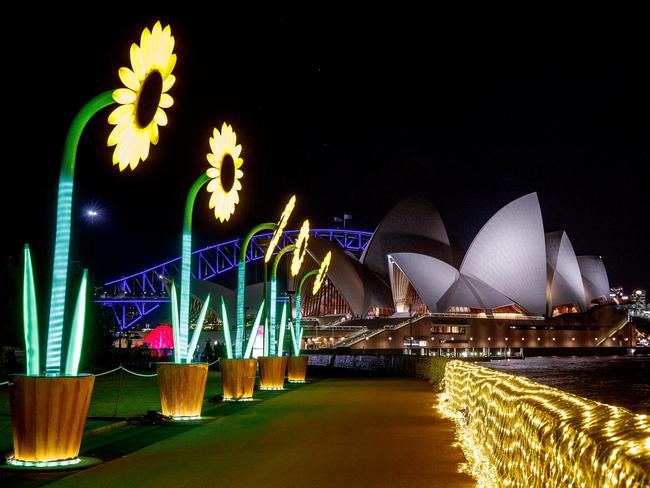
But pyrotechnic displays explode in a blaze of colour and burn out after 20 minutes or so. Light shows can brighten a city all night, such as the laser beams and sky-sweeping lights seen during the Sydney Olympics and the Brisbane Festival.
Vivid Sydney made an annual event out of midwinter illuminations, with colourful projections on to buildings around Circular Quay. At the first festival in 2009, the Opera House sails lit up with colours and shapes like an enormous lava lamp, in an installation by Brian Eno.
“We figured that Sydney was missing out on something to do in the winter months,” says Anthony Bastic, an events producer who helped devise the first Vivid light festival. “We took a proposal to the state government and said we’d like to create a new festival for Sydney, a light festival. Light art was a fairly new genre then, and building projections were kind of unheard of.”
Bastic’s company AGB Events runs light festivals such as Halo in Townsville and Parrtjima in Alice Springs. The attractions there include displays of Indigenous art projected or “grounded” on to the red earth, and a light show across 2km of the MacDonnell Ranges.
“Light festivals overcome language barriers and a lot of physical barriers, and you can bring art and culture to life,” Bastic says. “People like to be together. That’s why I think (Illuminate) Adelaide will go very well. This lockdown has proven that we just want to be out and together again.”
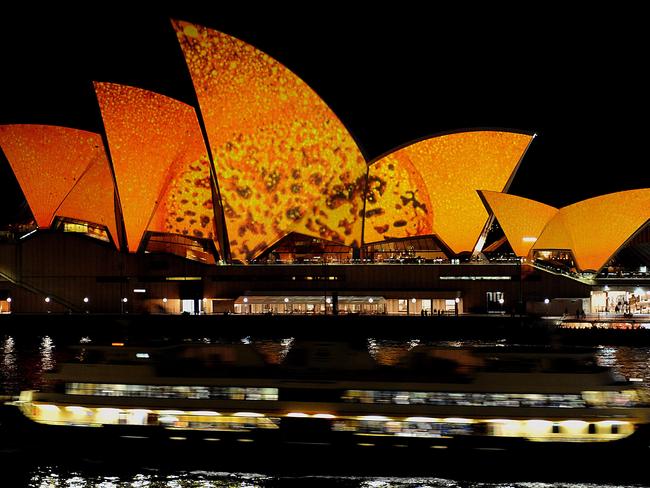
Technology has advanced considerably since the first Vivid Sydney when, Bastic says, the projections were little more sophisticated than a slide show. Digital projectors and projection-mapping technology now allow for animated displays that accurately track the projected surface, even if the “screen” is a building as sculptural as the Opera House.
Vivid Sydney, delayed until September because of the Sydney lockdown, will again feature the Lighting of the Sails, as the Opera House illumination is called. A large painting by eight women from Martumili Artists in the Pilbara has been digitally enhanced and animated, in effect creating a new artwork. The painting, Yarrkalpa – Always Walking Country, 2014 represents the desert country of the Martu, including its waterways, the different seasons, and cycles of hunting and grass-burning. In the digital rendering of it by events producer Curiious, the painted landscape has been subtly animated and details teased out to create three-dimensional effects.
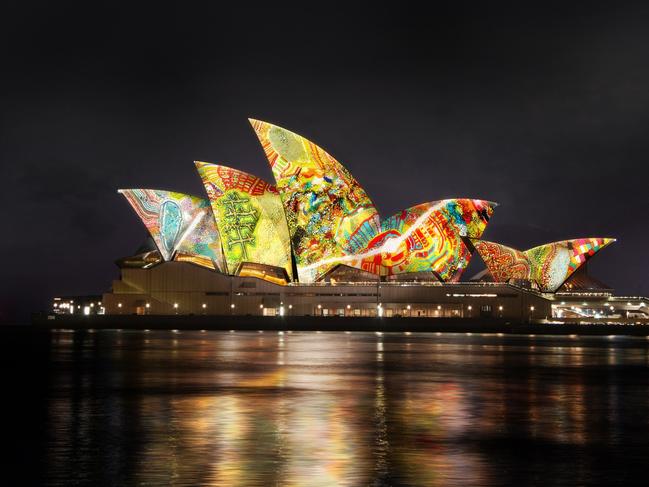
Curiious creative director Frederic Simard says the idea is to project the painting on to the Opera House so the viewer has a sense of travelling across and through the landscape. It has involved collaboration with the Martu artists, with Indigenous animators from the University of Technology Sydney and with musical duo Electric Fields, which produced the soundtrack.
“Our aim was to bring a new perspective to the artwork,” Simard says. “It’s quite overwhelming when you stand in front of it; there is so much detail and colour … We extract elements from the painting and create a composition with those elements on the (Opera House) sails. It’s not just a flat representation of the painting.”
Reimagining artworks as over-size, digital projections is behind the success of Melbourne company Grande Experiences, whose attractions include Monet and Friends and Van Gogh Alive.
Housed in vast marquees and exhibition halls, and using a proprietary system called SENSORY4, these “experiences” take the idea of son et lumiere to another dimension, involving not only sound and light but smell, drinks and food. Visitors can walk across a replica Japanese bridge similar to the one at Monet’s Giverny or imagine they are flying among the stars of van Gogh’s Starry Night.
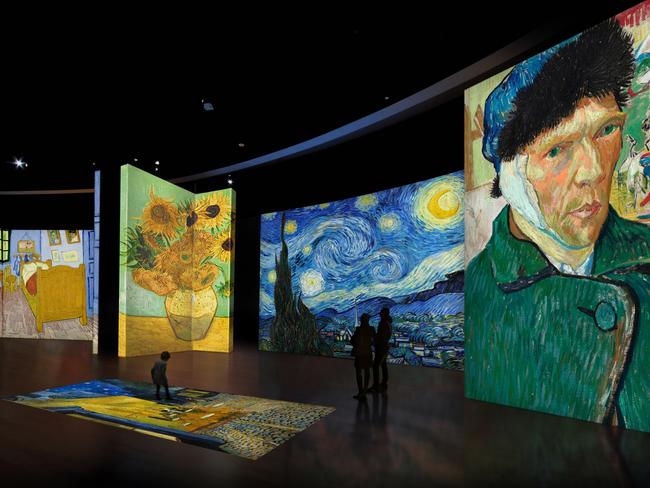
Grande Experiences has staged its attractions in dozens of cities worldwide, and is about to open permanent venues, called The Lume, in Melbourne and Indianapolis. Founder and owner Bruce Peterson says combined ticket earnings are up to $US70m.
Van Gogh’s Sunflowers, the original painting from the National Gallery in London, was in Canberra recently for the Botticelli to Van Gogh exhibition. Wouldn’t it be better to see the real thing – not a virtual van Gogh?
“It’s definitely not meant to replace, it’s meant to inspire people to enjoy art,” Peterson says of the projected paintings. “I firmly believe that people are in a far better place in their hearts and souls if they’re engaged in culture. The issue is the way it’s presented (in galleries) – for a large percentage of the population, if it doesn’t resonate, they don’t go. Or they may have gone to Canberra to see the original Sunflowers – that’s irreplaceable. But does that give them a full appreciation of Vincent, and his work, and how it changed over the years, and how it changed with his emotional battles?”
Visitors to Moment Factory’s Light Cycles will experience an interpretation of the natural environment, made with electronic light. It’s meant to be eye-dazzling and photogenic, but Grainger says he hopes people will put their phones away and simply experience being in the moment.
“People are surprised, they don’t know how to take it all in – they slow down, choose their own pace, take their time to connect with what they’re seeing,” he says. “There are moments of introspection, there are moments where you go with the flow. We are hoping that people will live this together as a communal experience.”
Illuminate Adelaide, Saturday to August 1. Vivid Sydney, September 17 to October 9. The Lume opens in Melbourne on September 1.

To join the conversation, please log in. Don't have an account? Register
Join the conversation, you are commenting as Logout